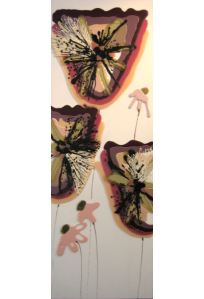
Its been a long road with my good friend, artist Sue Bartlett. She is of ‘mature years’ and yet has clearly always had a talent for artistic expression. She is also one of the most vibrant, optimistic and ‘present’ people I know – which it has to be said is unusual for an artist. This boundless energy and enthusiasm of a person awake and alive in a world full of colour and potential, sings in her work.
I first met Sue when I stumbled through her art class on my way to my pottery workshop where I was making handbuilt goddess figures, much to the concern of the vicar’s wife who sat next to me and worried that I was gong to start on a male version, which sadly I did not get the opportunity to do. This was because Sue, in her bright eyed way and showing me her beautiful and impressive nudes, drew me right into her art class, and there is another story…
A couple of years later Sue emailed me to say that she had been to look at a BA Fine Arts course and the smell of the paint and the stacked up easels had been too much for her, and she had enrolled on a three-year part time degree course. I saw less of her as she slogged it out, working very hard to fit the degree in with running her business. I had the pleasure of student shows, one of which was in Brick Lane in London, and supported Sue both with presence and encouragement, watching her develop and grow through some tough feedback from her tutors. For me, she was a perfect example of someone who listens, takes on feedback well, uses it and grows with it. When we are able to do this we push ourselves into the achievement of our potential. This is what Sue has done.
Since Sue completed her degree she has become highly successful. When she takes her work into galleries it is often described as ‘sumptous’ and it is highly unusual, vibrant, colourful and organic, using coloured wax as its main medium. She is a top seller accross Berkshire, Oxfordshire and Surrey and we suspect that one mega superstar, who the gallery owner quite rightly would not reveal, now owns one of her ‘cup cakes’ – a favourite theme.
What is wonderful for Sue is that she has now been able to devote more of her time to her art, and works for 3 days a week from her studio! She has taken some convincing of the fact, but she is now a genuine, real McCoy, practising artist!
All this would explain my great pleasure to recieve my beautiful invitation yesterday to Sue’s very first solo exhiition at one of Oxford’s most prestigious galleries. Sue has been working hard in recent months to produce an impressive body of new work. The exhibition, entitled ‘Pausias Passion’ at Sarah Wiseman Gallery in Summertown, Oxford, promises to be a visual treat, and well worth a look at.
